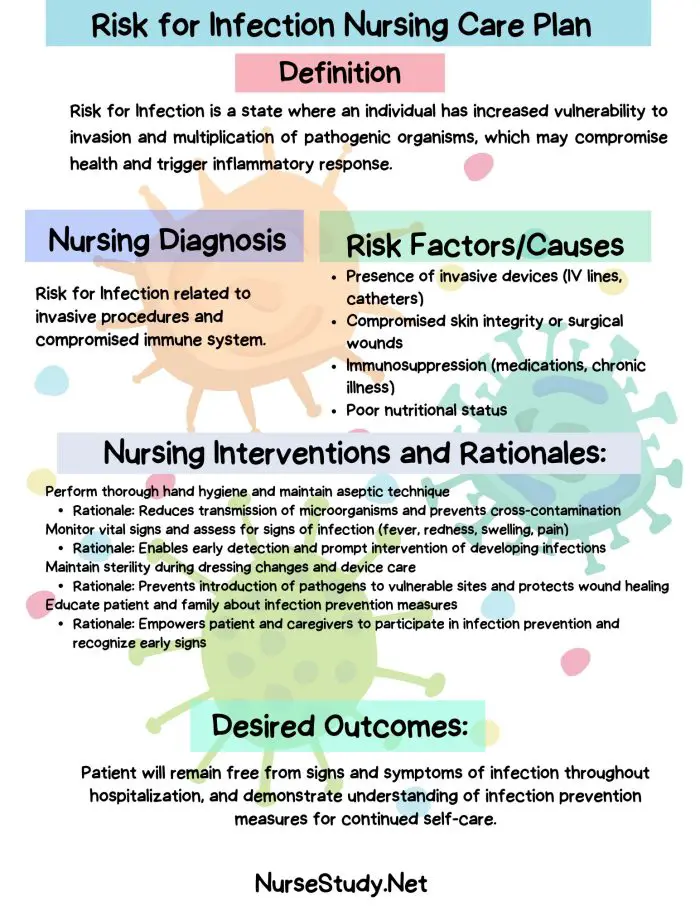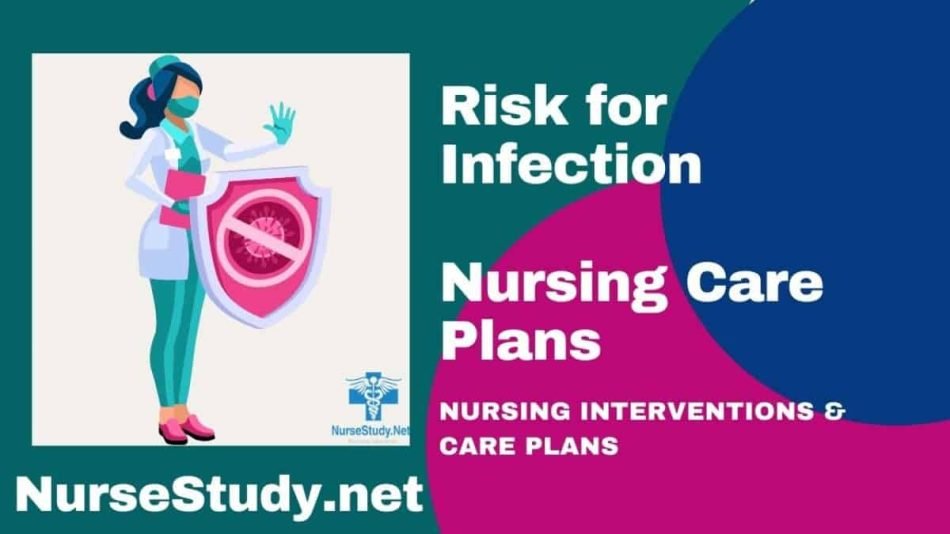Risk for Infection is a critical nursing diagnosis that identifies patients who are more susceptible to infections due to compromised immune defenses, invasive procedures, or chronic illnesses.
Recognizing and addressing this risk early is essential for preventing complications, promoting healing, and ensuring patient safety in all clinical settings.
For nursing students preparing for the NCLEX, understanding this diagnosis involves being able to assess, plan, and implement interventions that reduce exposure to pathogens and strengthen the host’s defenses.
Definition
The nursing diagnosis Risk for Infection refers to an increased vulnerability to pathogenic organisms, which may lead to illness if not properly managed. Patients with invasive lines, surgical wounds, or conditions that impair immune function are at higher risk. Early recognition and consistent application of infection control measures are essential components of nursing care.
Pathophysiology Summary
Infection occurs when microorganisms invade and multiply within the body’s tissues, triggering an immune response. The body’s natural defense mechanisms—such as intact skin, mucous membranes, inflammatory responses, and immune cell activity—protect against infection. When these barriers are compromised by injury, illness, or medical interventions, pathogens gain entry, leading to potential infection.
Common factors increasing susceptibility include:
- Breaks in skin or mucosal integrity (wounds, IV lines, catheters)
- Decreased white blood cell count or neutropenia
- Malnutrition or dehydration
- Chronic diseases such as diabetes or cancer
- Prolonged hospitalization or surgical procedures
- Inadequate hand hygiene or aseptic practices
Assessment and Diagnostic Cues
- History: Chronic illness, recent surgery, immunosuppressive therapy, prolonged antibiotic use
- Physical Assessment: Redness, warmth, swelling, drainage, or fever
- Laboratory Findings: Elevated WBC count, positive cultures
- Environment: Presence of invasive devices, unclean surroundings, exposure to infectious agents
Nursing Care Plans for Risk for Infection
Below are five detailed care plans to guide clinical and exam preparation.
Nursing Care Plan #1: Surgical Wound Patient
Nursing Diagnosis:
Risk for Infection related to surgical incision and invasive procedure.
Related Factors:
Break in skin integrity and exposure to the hospital environment.
Nursing Interventions and Rationales:
- Assess the wound site for signs of redness, swelling, or drainage to detect early indications of infection.
- Maintain strict hand hygiene before and after wound care to prevent transmission of microorganisms.
- Use sterile technique during dressing changes to minimize the introduction of pathogens.
- Encourage adequate protein and fluid intake to support tissue repair.
- Educate the patient on proper wound care at home.
Desired Outcomes:
The patient’s wound will remain clean and free from infection during hospitalization and at discharge.
Nursing Care Plan #2: Immunocompromised Patient (Chemotherapy)
Nursing Diagnosis:
Risk for Infection related to decreased white blood cell count secondary to chemotherapy.
Related Factors:
Neutropenia and reduced immune response.
Nursing Interventions and Rationales:
- Implement protective isolation to reduce exposure to pathogens.
- Limit visitors and ensure staff wear PPE when entering the room.
- Monitor CBC and report significant drops in WBC or ANC.
- Encourage good oral hygiene to prevent mucosal breakdown.
- Avoid fresh fruits, flowers, or raw foods that may carry bacteria.
Desired Outcomes:
The patient will remain afebrile and exhibit no signs of infection throughout treatment.
Nursing Care Plan #3: Diabetic Patient with Foot Ulcer
Nursing Diagnosis:
Risk for Infection related to impaired tissue perfusion and delayed wound healing.
Related Factors:
Hyperglycemia and peripheral neuropathy.
Nursing Interventions and Rationales:
- Inspect feet daily for cracks, redness, or wounds.
- Maintain blood glucose within the prescribed range to promote healing.
- Encourage proper footwear and foot hygiene.
- Use aseptic technique for dressing changes.
- Educate on the importance of routine podiatric care.
Desired Outcomes:
The patient’s foot will remain free of infection, and wound healing will progress without complications.
Nursing Care Plan #4: Indwelling Catheter Patient
Nursing Diagnosis:
Risk for Infection related to urinary catheter placement.
Related Factors:
Presence of an invasive device and stagnant urine.
Nursing Interventions and Rationales:
- Ensure catheter insertion and maintenance follow sterile technique.
- Keep the collection bag below the bladder level to prevent backflow.
- Perform perineal care daily and after bowel movements.
- Encourage adequate fluid intake to maintain urine flow.
- Remove the catheter as soon as clinically indicated.
Desired Outcomes:
The patient will show no symptoms of urinary tract infection, and the urine culture will remain negative.
Nursing Care Plan #5: Malnourished Older Adult
Nursing Diagnosis:
Risk for Infection related to poor nutritional status and decreased immune function.
Related Factors:
Protein deficiency and decreased skin integrity.
Nursing Interventions and Rationales:
- Assess dietary intake and collaborate with a dietitian for a high-protein meal plan.
- Encourage consumption of vitamin C and zinc to boost immunity.
- Promote mobility and skin care to maintain circulation and prevent pressure injuries.
- Monitor temperature and WBC count for early detection of infection.
- Provide education on a balanced diet and hydration.
Desired Outcomes:
The patient will maintain intact skin, normal temperature, and stable lab values without infection.
Patient Education and Safety
- Teach proper handwashing technique using soap and water for at least 20 seconds.
- Reinforce adherence to vaccination schedules.
- Educate patients and families on recognizing early signs of infection (fever, redness, swelling).
- Instruct on wound and catheter care at home.
- Encourage proper nutrition and hydration to support the immune system.
Frequently Asked Questions
1. What is the nursing diagnosis “Risk for Infection”?
It identifies patients more likely to develop infections due to compromised defense mechanisms or exposure to pathogens.
2. How can nurses prevent infections in clinical settings?
By maintaining hand hygiene, using PPE correctly, performing sterile procedures, and educating patients on infection control.
3. What are common risk factors for infection?
Immunosuppression, chronic disease, poor hygiene, the use of invasive devices, and malnutrition.
4. What outcomes indicate successful infection prevention?
Absence of fever, normal WBC count, intact skin, and no signs of redness or drainage.
5. How does patient education help reduce infection risk?
It empowers patients to recognize infection symptoms and practice safe hygiene and care routines.
More Nursing Care Plan Suggestions
- Anxiety Nursing Diagnosis
- Ineffective Tissue Perfusion Nursing Diagnosis
- Activity Intolerance Nursing Diagnosis
- Decreased Cardiac Output Nursing Diagnosis
- Chest Pain Nursing Diagnosis
Peer-Reviewed References
- Lewis, S. L., Bucher, L., Heitkemper, M. M., & Harding, M. (2023). Medical-Surgical Nursing: Assessment and Management of Clinical Problems. Elsevier.
- Potter, P. A., & Perry, A. G. (2023). Fundamentals of Nursing. Elsevier.
- Hinkle, J. L., & Cheever, K. H. (2022). Brunner & Suddarth’s Textbook of Medical-Surgical Nursing. Wolters Kluwer.
- Taylor, C., Lynn, P., & Bartlett, J. (2023). Taylor’s Clinical Nursing Skills. Wolters Kluwer.
- Ignatavicius, D. D., & Workman, M. L. (2022). Nursing Interventions for Clinical Practice. Elsevier.

